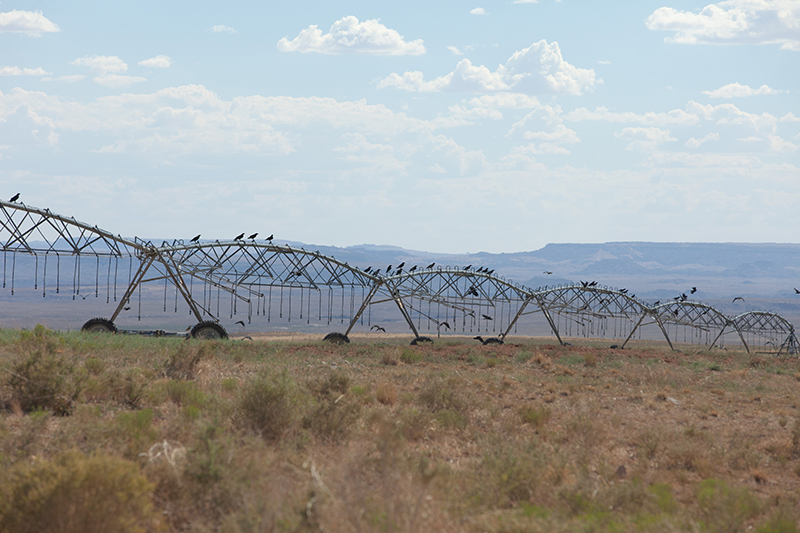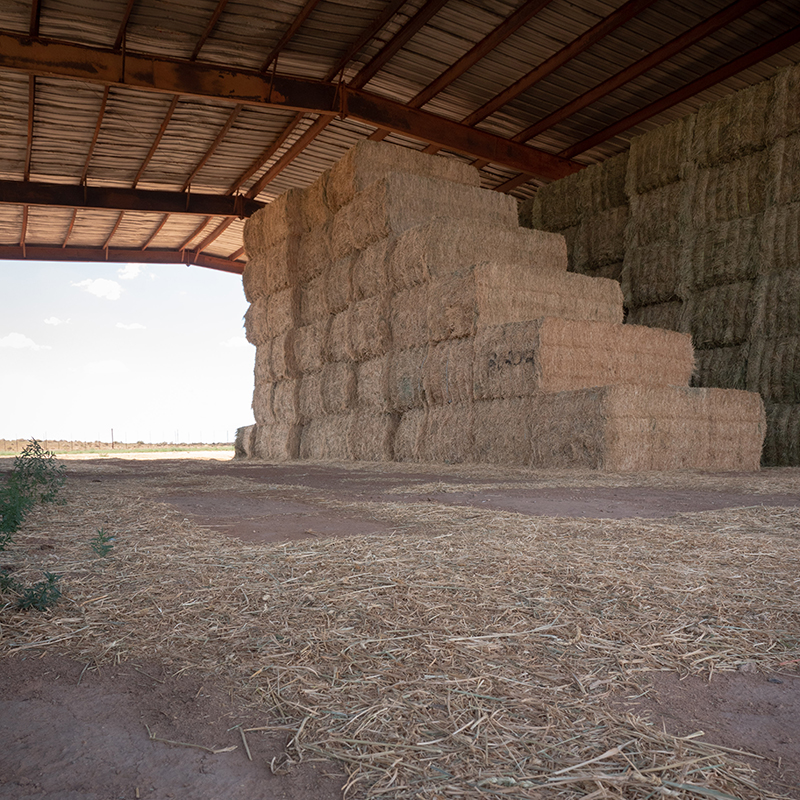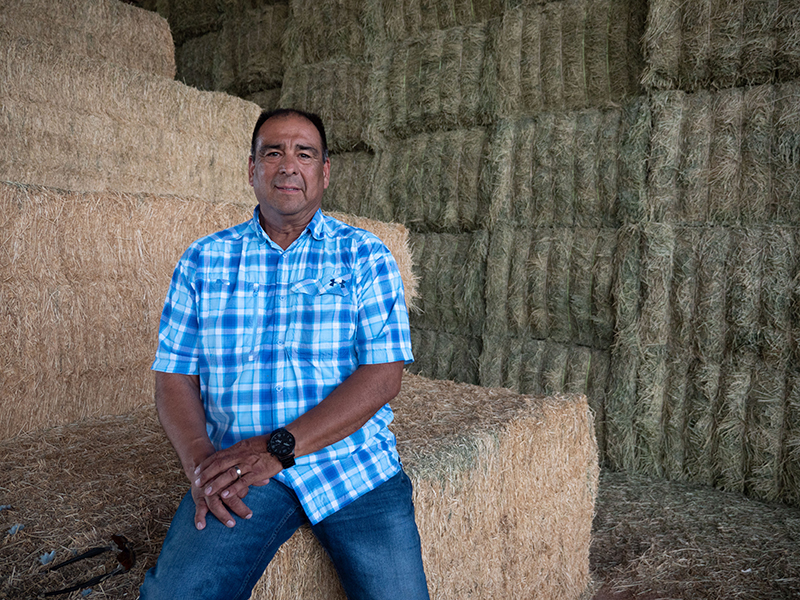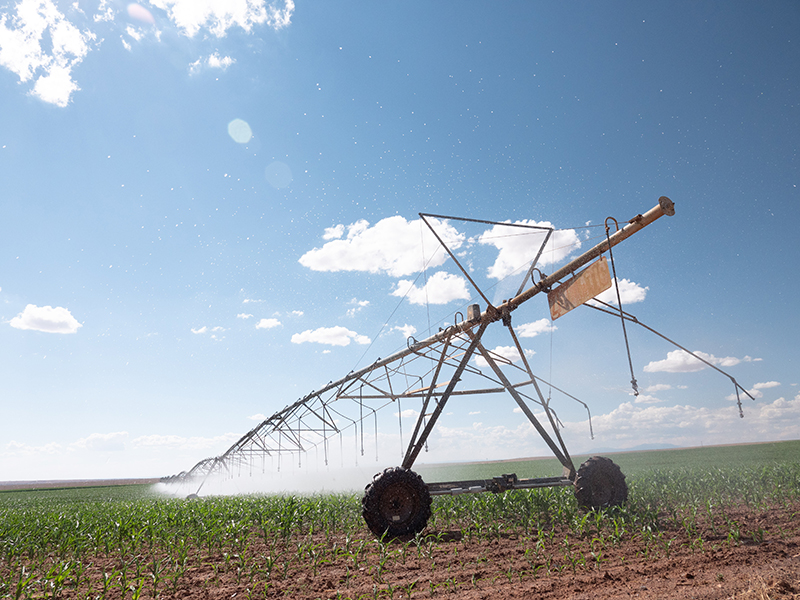
Due to record drought conditions, the Ute Mountain Ute Tribe Farm & Ranch Enterprise in southwest Colorado is operating on a fraction of the water needed to grow crops, resulting in dormant fields and irrigation systems. Photos by Corey Robinson
Due to record drought conditions, the Ute Mountain Ute Tribe Farm & Ranch Enterprise in southwest Colorado is operating on a fraction of the water needed to grow crops, resulting in dormant fields and irrigation systems. Photos by Corey Robinson
In late June, Simon Martinez drove along one of the dirt roads crisscrossing the parched rocky shrubland on the Ute Mountain Ute Tribe Farm & Ranch Enterprise, a 7,700-acre agricultural operation owned by the Ute Mountain Ute Tribe in the far southwestern corner of Colorado. In normal times, he would be driving past giant circular fields of corn and alfalfa irrigated by 110 rotating sprinklers called pivots. But this year most of the fields are barren, casualties of an unprecedented drought—“the worst in 30 years,” said Martinez, the general manager of the Farm & Ranch Enterprise and its subsidiary, the Bow & Arrow Brand LLC, which produces corn products.
Born in Grants, N.M., Martinez has been here since the beginning of the farm three decades ago, when the land was still barren and the newly created Towaoc Highline Canal began delivering water from McPhee Reservoir, 40 miles north, to its terminus on a hillside overlooking the Farm & Ranch Enterprise. But the cumulative effects of a 20-year drought on the Western Slope, combined with two years of poor winter snowpack in the San Juan Mountains and no monsoon rains, have hammered water levels in the reservoir.
This year, the Dolores River is expected to have its fourth-lowest runoff on record, resulting in major cuts to the water that farms and ranches receive from McPhee. The Farm & Ranch Enterprise is getting just 10% of their 24,000 acre-feet water allocation from McPhee, which means Martinez has had to slash corn production from 2,000 acres to 500 acres and hay production from 30,000-40,000 bales (each weighing three quarters of a ton) to just 2,000.

Birds sit atop an unused pivot at the Farm & Ranch Enterprise.
For the surrounding tribal community, those numbers mean lost jobs, revenue and livelihoods. Martinez had to let go 50% of the Farm & Ranch’s employees, half of whom are tribal members who live in nearby Towaoc, the Ute Mountain Ute Tribe’s headquarters and main town on their reservation.
Like many Indigenous communities, the Ute people are on the frontlines of a changing climate. As the Southwest becomes hotter and drier, the tribe is facing their latest threat in a long struggle to secure the water supply they were guaranteed when the federal government established reservations for Native tribes, promising a permanent and livable homeland for those it had displaced from their ancestral lands—a struggle marked by deprivation and, ultimately, resilience.
“This is one of the toughest years I’ve seen, but we will survive,” said Eric Whyte, the hay manager at the Farm & Ranch Enterprise and a member of the Ute Mountain Ute Tribe. “It’ll come back—or if it doesn’t, we’ll have to adapt.”

A hay barn at the Farm & Ranch Enterprise sits only partially full after another year of drought.
***
For thousands of years the Ute people, a collection of 13 hunter-gatherer bands, moved with the seasons through 130,000 square miles of high mountains, lush river valleys and high desert of what is now Colorado, eastern Utah and northern New Mexico. But as white settlers expanded into the West, they forced the Utes to give up the largest and best portions of their territory through various treaties with the U.S. government, squeezing them onto three small reservations, two in southwestern Colorado and one in northeastern Utah.
The Weeminuche band of Utes, comprising the Ute Mountain Ute Tribe, ended up on a patch of high desert south of Cortez, Colo. at the base of Sleeping Ute Mountain. Yearly rainfall averages just five to seven inches, but the landmark 1908 Winters v. United States Supreme Court decision clarified the rights of U.S. tribal nations to enough water for tribes to fulfill the “purpose” of the reservation, which generally included agriculture. As part of its ruling, the Supreme Court included that tribal water rights dated back to the establishment of either a treaty or reservation—1868 in the case of both Ute reservations in Colorado—and could not be lost through non-use.
For the Ute Mountain Ute Tribe, however, 86 years passed from when the Winters ruling was issued and water actually flowed onto the reservation. Though the 20th century ushered in an era of dam-building throughout the West, allowing cities and agriculture to flourish in arid lands, the tribe received nothing, though they had among the most senior water rights in the region, dating back to the 1868 “Kit Carson Treaty” creating the reservation.
Up until the late 1980s, homes in Towaoc had no drinking water or indoor plumbing. Manuel Heart, the tribal chairman, recalls driving with his grandfather, who raised him, to a laundromat in Cortez, 15 miles away, to shower and wash their clothes.
“We’re the oldest living residents of the state of Colorado,” Heart said. “We’ve been here for 10,000 years or more, but we were living in the equivalent of a third-world country.”
In need of water, the tribe began pushing lawmakers to provide the water to which they were legally entitled. With the most senior water rights in the region, the Utes could have claimed water from the Mancos River, where reservoirs had already been built, but that would have taken water from existing farms and communities. Plus, there was no infrastructure to transport the water to Towaoc.
So the tribe negotiated: in exchange for federal funding to build a reservoir on the Dolores River and infrastructure to deliver water to the reservation, the tribe gave up its more senior water rights on the Mancos River. Congress ratified the Colorado Ute Indian Water Rights Settlement Act in 1988, settling the tribes’ outstanding reserved water rights on the Mancos, Animas and La Plata rivers.
Still, the deal was not a fairytale ending to the Utes’ long struggle for water. Like many cash-poor tribes, during the negotiations, the Utes were forced to accept lesser amounts of water and later priority dates in return for help getting water to their reservation—water that they were legally owed. Under the settlement, the Tribe’s new water rights on the Dolores River were subordinated to water rights older than the Dolores Project, and thus more susceptible to cuts in the event of a drought.
“Indian tribes across this country have always given up a lot of things but never gotten things back in return,” Heart said. “They [the U.S. government] keep taking and taking and then we have to negotiate with them. We end up sacrificing something to get something.”
***
Heart was a teenager when the McPhee Reservoir filled in 1986. Eight years later, water flowed from the reservoir through a pipeline to homes in Towaoc. Heart’s house now had a spigot out back, but it would take a few more years for a water line to reach his house.
Water from the Dolores project also created new economic opportunities for the tribe, like the Ute Mountain Casino and the Ute Mountain Farm & Ranch Enterprise, which, in addition to corn and alfalfa, includes a 650-head cow-and-calf operation and the Bow & Arrow brand mill. The mill started in 2014 as a way to diversify the farm’s operations towards more value-added products that have longer shelf lives and generate more consistent revenue during dry years. This year, for instance, the mill will draw on corn stored from last year’s harvest to produce its 15 different varieties—including yellow, white and blue cornmeal; grits; polenta; yellow corn flour; clean, shelled corn; and cracked-corn feed—all of which are certified non-GMO, whole grain, gluten free and kosher.
Inside the mill, bags of corn weighing 2,000 pounds or more are stacked on pallets in the back room where 28-year-old Ethan Summa works amid the whir of machinery capable of churning out 1,500 bags of corn every day—enough to fill two semi-trucks.
Summa, a Ute tribal member, began working at the Farm & Ranch Enterprise almost a year and a half ago, first on the irrigation crew before landing a job at the mill. He grew up in Towaoc, but left the reservation for high school, bouncing around various jobs in his early twenties—firefighter, search and rescue volunteer, security guard at the tribal casino.
“I lost my job and winded up in a tough space,” Summa said. “This was my second chance.”

Ethan Summa works at the Bow & Arrow mill in Towaoc, Colo.
More recently, the one-two punch of the pandemic and the drought reinforced to Summa that the Farm & Ranch Enterprise is more than a job or even a business, but a crucial source of support for his community. When the Ute Mountain Casino shut down during the worst of the COVID-19 crisis, the tribe lost a major revenue stream and key employer. But as an essential business, the Farm & Ranch Enterprise stayed open, donating beef and corn to help out the local community.
“That was the coolest thing,” Summa said. “People helped each other out to get through.”
Though the water cuts have forced Martinez to lay off many of the Farm & Ranch Enterprise staff, he was able to keep all 12 of the mill’s employees hired. Summa is one of the lucky ones, but he worries about the future.
“Everyone is going to be hit by the drought,” he said

Simon Martinez, the general manager of the Farm & Ranch Enterprise.
***
Throughout the Colorado River Basin, other tribes are also struggling to access a secure water supply in the face of climate change and federal neglect. A recent report from the Water & Tribes Initiative documents the lack of water security in Native communities within the Colorado River Basin, despite the various treaties and laws addressing the federal government’s responsibilities to them.
Thanks to the Dolores project, the majority of Ute Mountain Ute tribal members living in Towaoc have clean running water in their homes. Yet tribal leaders worry that the region’s changing climate will diminish the water resources they need for the future. Springs are drying up across the Ute Mountain Ute Reservation and the Mancos River is “barely a trickle,” said Scott Clow, the environmental programs director for the Ute Mountain Ute Tribe.
Frustratingly, the tribe owns 16,000 acre-feet of water in Lake Nighthorse, a reservoir 60 miles east of Towaoc, but cannot access the water. The lake is part of the Animas-La Plata project, built to fulfill the Southern Utes’ and Ute Mountain Utes’ water rights (and paid for in part by both tribes). During negotiations over the project in the 1990s, environmentalists opposed to building another dam successfully pushed to downsize the project, which pumps water from the Animas River to Lake Nighthorse. The final budget eliminated the funding that would have paid for a delivery system from Lake Nighthorse to the Ute Mountain Ute Reservation.
Those kinds of funding shortfalls are among the factors identified in the Water & Tribes Initiative report that contribute to water insecurity in tribal communities throughout the Colorado River Basin.
“Access to water takes many forms,” said Heather Tanana (Diné), the lead author of the Water & Tribes Initiative report. “Most people think about it in terms of pipes not getting to homes, which definitely exists in many parts of Colorado River Basin reservations, but can also take other forms,” she said, noting that contamination and deteriorating infrastructure are some of the main factors contributing to tribes’ lack of water security.
According to Heart, the Ute Mountain Ute Tribe had been hoping to build another community—on tribal trust land in New Mexico, or on the eastern side of the reservation below the town of Hesperus—to expand infrastructure and housing for tribal members. They were also looking into developing some projects that could help expand the Farm & Ranch Enterprise. “But we can’t grow these projects if we don’t have water,” he said.
***
Martinez stopped beside one of the few green corn fields with a pivot moving slowly across its surface, a plume of mist trailing behind. With this year’s allotment, they can only water one inch per week—“spoon feeding,” Martinez calls it. They have 22 inches—enough for 3-4 more weeks of growing—before the water valves turn off.
With such a small harvest, the Farm & Ranch Enterprise won’t be able to sell enough hay and corn to afford the annual roughly $500,000 operations and maintenance fee it pays the Dolores Water Conservancy District to use the Towaoc Highline Canal—whether or not they receive their full water allocation. Currently, the Farm & Ranch Enterprise and the tribe’s legal team are working with the Bureau of Reclamation to figure out some financial assistance to help lessen the drought’s financial burden.
Going forward, Martinez knows the Farm & Ranch Enterprise will have to adapt to a changing climate to survive. “If we have to farm less acres because we have less water, we have to become better users of our water,” he said. Growing hemp seed is one possibility. Another is using the lessons they’ve learned from the Bow & Arrow mill: growing less corn for more money and developing other products.
Back at the Farm & Ranch Enterprise headquarters, Whyte, the hay manager, pointed to a barren, rocky hillside just outside the garage. Like Martinez, Whyte has been here since the beginning.
“It used to look like that,” he said, referring to the land on which the Farm & Ranch Enterprise now sits. For Whyte, being part of a successful business has enabled him to help pay for his kids to attend college, and he’s seen it create a community, too, bringing together tribal and non-tribal members.
Recently, Whyte was in Denver, where it had been raining. He wished he could bring some back west to his dry corner of Colorado. In the meantime, Whyte said, “We’re all in it together—a ship in no water.”

Carbondale, Colorado